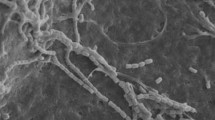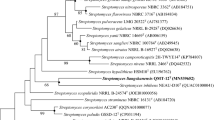Abstract
A novel endophytic actinomycete strain, designated KM-1-2T, was isolated from seeds of Ginkgo biloba at Yangling, China. A polyphasic approach was used to study the taxonomy of strain KM-1-2T and it was found to show a range of phylogenetic and chemotaxonomic properties consistent with those of members of the genus Streptomyces. The diamino acid of the cell wall peptidoglycan was identified as LL-diaminopimelic acid. No diagnostic sugars were detected in whole cell hydrolysates. The predominant menaquinones were identified as MK-9(H6) and MK-9(H8). The diagnostic phospholipids were found to be phosphatidylethanolamine and phosphatidylcholine. The DNA G + C content of the novel strain was determined to be 72.9 mol%. The predominant cellular fatty acids (> 10.0 %) were identified as iso-C14 : 0, iso-C16 : 0, C16 : 0 and C17 : 0 cyclo. Phylogenetic analysis based on the 16S rRNA gene sequence revealed that the strain is closely related to Streptomyces carpaticus JCM 6915T (99.3%), Streptomyces harbinensis DSM 42076T (98.9%) and Streptomyces cheonanensis JCM 14549T (98.5%). DNA-DNA hybridizations with these three close relatives gave similarity values of 39.1 ± 1.9, 35.8 ± 2.3, and 47.4 ± 2.7%, respectively, which indicated that strain KM-1-2T represents a novel species of the genus Streptomyces. This is consistent with the morphological, physiological and chemotaxonomic data. Cumulatively, these data suggest that strain KM-1-2T represents a novel Streptomyces species, for which the name Streptomyces ginkgonis sp. nov. is proposed, with the type strain KM-1-2T (= CCTCC AA2016004T = KCTC 39801T).


Similar content being viewed by others
References
Cao LX, Qiu ZQ, You JL, Tan HM, Zhou S (2004) Isolation and characterization of endophytic Streptomyces antagonists of Fusarium wilt pathogen from surface sterilized banana roots. FEMS Microbiol Lett 247:147–152
Collins MD (1985) Isoprenoid quinone analysis in classification and identification. In: Goodfellow M, Minnikin DE (eds) Chemical methods in bacterial systematics. Academic Press, London, pp 267–287
Felsenstein J (1985) Confidence limits on phylogenies: an approach using the bootstrap. Evolution 39:783–791
Fitch WM (1971) Toward defining the course of evolution: minimum change for a specific tree topology. Syst Zool 20:406–416
Hain T, Ward-Rainey N, Kroppenstedt RM, Stackebrandt E, Rainey FA (1997) Discrimination of Streptomyces albidoflavus strains based on the size and number of 16S-23S ribosomal DNA intergenic spacers. Int J Syst Bacteriol 47:202–206
Haritha R, Sivakumar K, Swathi A et al (2012) Characterization of marine Streptomyces carpaticus and optimization of conditions for production of extracellular protease. Appl Environ Microbiol 78:4826–4834
Hwang KS, Kim HU, Charusanti P, Palsson BØ, Sang YL (2014) Systems biology and biotechnology of Streptomyces, species for the production of secondary metabolites. Biotechnol Adv 32:255–268
Kämpfer P, Kroppenstedt RM (1996) Numerical analysis of fatty acid patterns of coryneform bacteria and related taxa. Can J Microbiol 42:989–1005
Kelly KL (1964) Inter-Society Color Council-National Bureau of Standards color name charts illustrated with centroid colors. US Government Printing Office, Washington
Kimura M (1980) A simple method for estimating evolutionary rates of base substitutions through comparative studies of nucleotide sequences. J Mol Evol 16:111–120
Kirkpatrick M, Dugatkin LA (2015) Antimicrobial and antioxidant activities of a new benzamide from endophytic Streptomyces sp. YIM 67086. Nat Prod Res 29:331–335
Kumar S, Stecher G, Tamura K (2016) Mega7: molecular evolutionary genetics analysis version 7.0 for bigger datasets. Mol Biol Evol 33:1870
Labeda DP, Goodfellow M, Brown R, Ward AC, Lanoot B, Vanncanneyt M et al (2012) Phylogenetic study of the species within the family streptomycetaceae. Antonie Van Leeuwenhoek 101:73–104
Lechevalier HA, Lechevalier MP (1980) The chemotaxonomy of actinomycetes. In: Dietz A, Thayer DW (eds) Actinomycete taxonomy. (Special Publication 6). Society of Industrial Biology, Arlington, pp 277–284
Lechevalier HA, Lechevalier MP, Gerber NN (1970) Chemical composition as a criterion in the classification of actinomycetes. Int J Syst Evol Microbiol 20(4):435–443
Lechevalier MP, Stern AE, Lechevalier HA (1981) Phospholipids in the taxonomy of actinomycetes. Zentralbl. Bakteriol. Parasitenkd. Infektionskr. Hyg. Abt. 1(Suppl. 11):111–116
Liu M, Abdel-Mageed WM, Ren B et al (2014) Endophytic Streptomyces sp. Y3111 from traditional Chinese medicine produced antitubercular pluramycins. Appl Microbiol Biotechnol 98:1077–1085
Loria R, Bukhalid RA, Fry BA, King RR (1997) Plant pathogenecity in the genus Streptomyces. Plant Dis 81:836–846
Mesbah M, Premachandran U, Whitman WB (1989) Precise measurement of the G+C content of deoxyribonucleic acid by high-performance liquid chromatography. Int J Syst Bacteriol 39:159–167
Passari AK, Mishra VK, Gupta VK et al (2016) Distribution and identification of endophytic Streptomyces species from Schima wallichii as potential biocontrol agents against fungal plant pathogens. Pol Soc Microbiol 65:319–329
Pridham TG, Gottlieb D (1948) The utilization of carbon compounds by some actinomycetales as an aid for species determination. J Bacteriol 56:107
Rainey FA, Ward-Rainey N, Kroppenstedt RM, Stackebrandt E (1996) The genus Nocardiopsis represents a phylogenetically coherent taxon and a distinct actinomycete lineage: proposal of Nocardiopsaceae fam. nov. Int J Syst Bacteriol 46:1088–1092
Rong X, Guo Y, Huang Y (2009) Proposal to reclassify the Streptomyces albidoflavus clade on the basis of multilocus sequence analysis and DNA-DNA hybridization, and taxonomic elucidation of Streptomyces griseus subsp. solvifaciens. Syst Appl Microbiol 32:314–322
Rosselló-Móra R, Trujillo ME, Sutcliffe IC (2017) Introducing a digital protologue: a timely move towards a database-driven systematics of archaea and bacteria. Syst Appl Microbiol 110:455–456
Saitou N, Nei M (1987) The neighbor-joining method: a new method for reconstructing phylogenetic trees. Mol Biol Evol 4:406–425
Shirling EB, Gottlieb D (1966) Methods for characterization of Streptomyces species. Int J Syst Bacteriol 16:313–340
Stackebrandt E, Rainey FA, Wardrainey NL (1997) Proposal for a new hierarchic classification system, Actinobacteria classis nov. Int J Syst Bacteriol 47:479–491
Stone JK, Bacon CW, White JF (2000) An overview of endophytic microbes: endophytism defined. Microb Endophytes 3:29–33
Thompson JD, Gibson TJ, Plewniak F, Jeanmougin F, Higgins DG (1997) The CLUSTAL X windows interface: flexible strategies for multiple sequence alignment aided by quality analysis tools. Nucleic Acids Res 25:4876–4882
Van de Peer PY, de Wachter R (1994) TREECON for Windows: a software package for the construction and drawing of evolutionary trees for the Microsoft Windows environment. Comput Appl Biosci 10:569–570
Waksman SA, Henrici AT (1943) The nomenclature and classification of the actinomycetes. J Bacteriol 46:337–341
Xiao J, Wang Y, Luo Y, Xie SJ, Ruan JS, Xu J (2009) Streptomyces avicenniae sp. nov., a novel actinomycete isolated from the rhizosphere of the mangrove plant Avicennia mariana. Int J Syst Evol Microbiol 59:2624–2628
Acknowledgements
This work was supported by Foundation Research Project of Shaanxi Province (No. 2017JZ006); National Natural Science Foundation of China (No. 31101476); Science and Technology Program of Yangling Demonstration Zone (No. 2014NY-41).
Author information
Authors and Affiliations
Corresponding author
Ethics declarations
Conflict of interest
Authors do not claim any conflict of interest.
Rights and permissions
About this article
Cite this article
Yan, X., Li, Y., Wang, N. et al. Streptomyces ginkgonis sp. nov., an endophyte from Ginkgo biloba . Antonie van Leeuwenhoek 111, 891–896 (2018). https://doi.org/10.1007/s10482-017-0987-3
Received:
Accepted:
Published:
Issue Date:
DOI: https://doi.org/10.1007/s10482-017-0987-3




